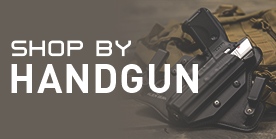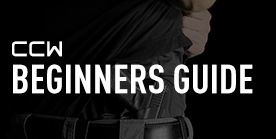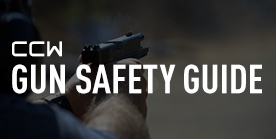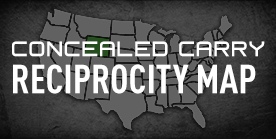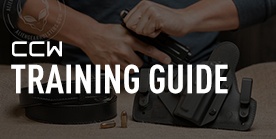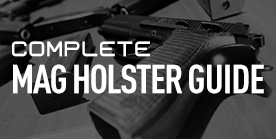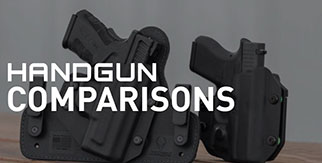
5 Shooting Drills For Concealed Carriers
If a person is going to concealed carry, shooting drills and other practice is warranted and on a more regular basis than recreational shooting. Shooting skills, like other skills, degrade and thus a person should be doing a certain amount of shooting every year to keep them honed.
For the concealed carrier, that means concealed carry techniques in lieu of traditional shooting techniques, and certainly bullseye shooting. Here are 5 concealed carry shooting drills that should help a person stay ready.
Simple Draw And Fire

The meat and potatoes concealed carry drill, the one a person should practice early and often and always, is a simple draw and fire. There are plenty of more advanced drills, but they all build from this one. Seems simple enough, but it's more complicated than one might think.
By way of analogy, when a racing driver takes a corner, it isn't just brake, turn and go. Braking starts at the latest possible point and stops at the earliest possible point. The turn begins at the best possible point to begin accelerating again as quickly as possible; many drivers hit curbs to follow the best racing line out of the apex of the corner. That's a lot to manage at more than 100 miles per hour.
To draw and fire, one has to clear the cover garment, draw, present, aim and fire - meaning there are five individual components of the action, which can be further broken down into several components themselves.
The drill is simple enough on paper - clear, draw, present, aim and fire at the target. You should practice with a target that simulates vital areas, such as a silhouette or QIT bottle target.
This drill should be practiced slowly, smoothly and efficiently until proficiency and speed are attained. To return to the racing analogy, slow is smooth and smooth is fast. Practice slow and perfect and eventually you'll be doing it fast and perfect.
The Wall Drill

The wall drill is a dry-fire drill, and it's some of the easiest, cheapest, best practice a person can get. The goal is to learn trigger control. Why is that important? Simple: one of the most common causes of shots that go off target despite the sights being right on target is the trigger pull taking the sights off target at the moment of truth.
Trigger control is what the wall drill works on.
It's a dry-fire drill and you can do it indoors, but before doing it - unload your firearm. Keep any ammunition well away. Before doing the drill, check to ensure your gun is unloaded. Then check again. Then check a third time. To make quadruply sure, insert a snap cap into the chamber.
Pick a point on the wall. Put the front sight about two inches away from it, acquiring the fixed point on the wall (such as a piece of texture) in a front sight picture. Slowly squeeze the trigger, paying attention to the front sight.
Do the sights move when you pull the trigger, losing the target? That means you need to work on trigger control. Keep at the drill until the sights don't move while you squeeze the trigger.
While this drill seems to skirt some conventions of gun safety, keep the gun pointed in as safe a direction as possible and ensure, repeatedly that the gun is not loaded. However, it's cheap, it's simple, it's easy and it can pay great benefits. This drill is especially good for people who are looking to get better at shooting a double-action trigger.
The Double Tap

One of the most practiced shooting drills by amateurs and professionals alike is the double tap. Also called "controlled pairs," it's fairly simple. Fire two shots in quick succession, grouping them as closely as possible.
Just like the draw and fire drill, start slowly as there's more to the drill than merely firing more than one shot. You get on target, fire, recoil, reacquire and fire again. Accuracy is part of the goal, and you can't be accurate if you aren't used to fast follow-up shots - so practice slow and perfect until you gain proficiency, efficiency and therefore speed.
Want to spice this drill up? Shoot one controlled pair with your strong hand, then a controlled pair with your weak hand. Another good variation is to shoot controlled pairs as part of a draw-and-shoot drill. Draw, double-tap, and reholster.
The Balance Drill: Another Dry Fire Drill

Another fantastic dry fire drill, and a great companion to the wall drill, is the balance drill. This drill also works trigger control, especially the pull.
Instead of focusing on a point, one holds one's pistol as flat and level as possible. Balance an object just behind the front sight. It can be a penny, a spent shell casing, or any small object. Then dry-fire. If the object doesn't move, you're doing the trigger pull right.
Just as with the wall drill, make sure your gun isn't loaded first. Then make sure again. Then make sure a third time. Then make sure there is no live ammunition near the gun. It's also a good idea to put in a snap cap to make darn good and sure.
Remember, point in a safe direction at all times.
The Tactical Reload

Another good shooting drill is a tactical reload. This does require a spare magazine; a magazine carrier also helps in this instance.
There are multiple versions of this drill, but the gist is that you load a small number of rounds in the magazine that's inserted into a pistol and fire them at the target. Eject the magazine and insert the spare. Load the pistol and continue firing.
Again, there are multiple variations on this theme. Some reload drills put two in the first magazine, and two in the backup, so the shooter can shoot two controlled pairs. Other variations may require more; such as three and three, or six and six, shooting three controlled pairs from each magazine. Pick the specifications that seem right to you or drill a variety of them once one has attained proficiency.
Make the drill more interesting by incorporating a tactical reload into a draw and fire drill. Want to make it more interesting? Fire one controlled pair from the strong hand only, reload, then fire another controlled pair from the weak hand.
There are plenty more concealed carry drills out there. Many are variations on one of these drills, with more complex motions added. However, these drills will give a person a handle on many of the basics, and in truth, if a person never practiced anything but these five drills, they'd be heads and shoulders above many carriers out there and, as always, time at the range is never a waste.
 |
About The Author Born in southeastern Washington State, Sam Hoober graduated in 2011 from Eastern Washington University. He resides in the great Inland Northwest, with his wife and child. His varied interests and hobbies include camping, fishing, hunting, and spending time at the gun range as often as possible. |


